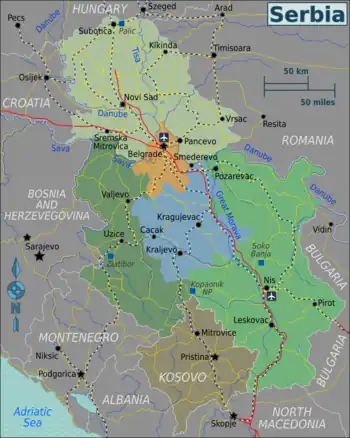Serbia
country in Southeast Europe
Serbia (Serbian: Србија, Srbija) is a Balkan country in Southeastern Europe. It is at the crossroads of European history, and as such is a mix of cultures, ethnicities and religions. It lies on one of the major land routes from Central Europe to the Near East. It was the dominant component of Yugoslavia, and considered to be its natural successor. Despite having developed as a tourist destination much later than neighbouring Croatia, it is also a varied and beautiful nation, offering a mixed scenery: from the plains of Vojvodina that remind one of the scenes from Dr. Zhivago in winter, to many mountains, lakes, and national parks. During the summer tourists love spending their time in Belgrade, seen as one of the up-and-coming capitals of Europe. In winter, they are attracted to the ski resorts, one of the most popular being Kopaonik. There are also many spa resorts. Serbia has a soulfulness and verve, coupled a gusto for good living, that are rare to find, while its people are some of the most hospitable and welcoming.
- Not to be confused with Republika Srpska, one of the constituent entity of Bosnia and Herzegovina.
Regions
Serbia can be divided into five regions and one de facto independent republic:
Disputed territory
|
We cover Kosovo in a separate article. While the legitimacy of the Kosovar government is disputed by many countries, from a traveller's point of view it has de facto control of the area (separate visas, laws, currency, etc.) This is not a political endorsement of claims by either side in the dispute. |
| Kosovo Serbia still claims Kosovo as its province, although it has been recognised by many nations and is de facto an independent republic. It has an ethnic Albanian majority; however, the northern, Serb majority part of Kosovo remains connected to Serbia. |
The status of Kosovo — an Albanian-majority land today though historically part of Serbia and the site of the 1389 Battle of Kosovo, to this day a highly charged event in which the Serbian defenders were annihilated but also killed most of the attacking Ottoman forces and the Ottoman Sultan in the process — is quite controversial in Serbia, which does not recognise the region as independent.
Cities
- 🌍 Belgrade (Beograd/Београд) — the capital of Serbia.
- 🌍 Kragujevac (Serbian Cyrillic: Крагујевац)— The first capital of modern Serbia, industrial hub and the 4th largest city in Serbia. Kragujevac is in the region Šumadija, 120 km south of Belgrade. Lepenica, a small river, flows through Kragujevac. Near the town is Lake Gružansko (Гружанско Језеро).The city has a university, and important cultural and medical buildings. It has a rich history and many cultural and historical monuments.
- 🌍 Kraljevo (Serbian Cyrillic: Краљево)-Kraljevo is an important economic centre in Serbia 170 km south of Belgrade. It lies on two rivers, the Morava and The Ibar river. In the outskirts of the city is very famous monastery Žiča (Жича) with a rich history, and in addition to the monastery and the famous Mataruška spa(Матарушка бања), and a little further Bogutovačka Spa(Богутовачка бања).
- 🌍 Niš (Serbian Cyrillic: Ниш) — The third largest city in Serbia. Niš is a great car and railway junctions in that part of Serbia and the Balkans, with great industry and a rich history and cultural-historical monuments.Niš has a large university, there are important cultural and medical buildings. Nearby is the famous Niska Banja(Нишка Бања). Among other things, Niš is the birthplace of Constantine the Great, where are the remains of his summer home.
- 🌍 Novi Sad (Serbian Cyrillic: Нови Сад) — Nicknamed "Serbian Athens", Novi Sad is the provincial capital of the Province of Vojvodina and the second largest city in Serbia (after Belgrade). Novi Sad is about 80 km northeast of Belgrade, on the Danube river. The city is an important industrial, cultural, educational, sport, and touristic centre with many cultural and historical monuments and museums. It contains well-known temples, the Petrovaradin fortress, and is in the vicinity of Fruška Gora hill, renowned for its vineyards, and for the Fruška Gora National Park. Fruška Gora is also home to many monasteries of the Serbian Orthodox Church (over 16 of them) and is sometimes referred to as "The Second Holy Mountain" (after Mount Athos). Southeast of the town, on the Syrmian side of the river, along the "old road" to Belgrade, lies the small town of Sremski Karlovci, which has a rich history, famous churches, buildings, museums, and famous wine cellars.
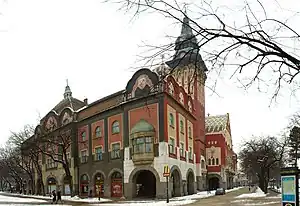
- 🌍 Požarevac (Serbian Cyrillic: Пожаревац) — One of the oldest cities in Serbia with a large historic heritage. An important commercial and cultural centre, in addition to the Velika Morava river, is situated about 80 km east of Belgrade. Near the town is a small town of Stari Kostolac where is the famous archaeological site Viminacium. In Požarevac was born former president of the Republic of Serbia - Slobodan Milošević (he was also buried there). Pozarevac is also known for Ljubičevo Equestrian Games.
- 🌍 Subotica (Serbian Cyrillic: Суботица) — has been rated as one of the most beautiful cities of Serbia. It is in North Serbia, and is the closest city to Palic. An important commercial and cultural centre with a rich history. The main languages are Serbian and Hungarian.In the vicinity of Subotica is a famous resort and lake Palić, and Ludoško lake.
- 🌍 Sremska Mitrovica (Serbian Cyrillic: Сремска Митровица) - Ancient Sirmium, one of four capitals of Roman Empire in 4th century AD.
- 🌍 Vršac (Serbian Cyrillic: Вршац) — One of the most beautiful cities in Serbia. It is 80 km northeast of Belgrade, near Romania. Vrsac has developed economic and cultural and sports centre, rich in vineyards.
Other destinations
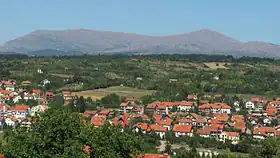
- 🌍 Đerdap National Park stretches along the right bank of the Danube River from the Golubac Fortress to the dam near Novi Sip. Its main attraction is the Đerdap gorge - the famous Iron Gate - the grandiose gateway through the southern slopes of the Carpathian mountains.
- 🌍 Kopaonik National Park (Serbian Cyrillic: Копаоник Н. П.) — and the ski-resort in the Kopaonik Mountain in southern Serbia. Kopaonik is the major ski resort of Serbia, with total of 23 ski lifts. A national park spread over 118.1 km² (45.6 sq mi). Kopaonik has a rich historical heritage. Sports and recreation are key factors to the tourism of Kopaonik. There are various other activities as well. Other features which attract tourists are a luxurious hotel, and entertainment. Kopaonik has many cafes, bars and night clubs.
- 🌍 Palić (Serbian Cyrillic: Палић) — the lovely lake area in the north with baroque parks, the monuments of art nouveau architecture and a long tradition in catering made it fashionable summer resort. Palić is the host of a film festival, World Ethno Music Festival, and various sporting events.
- 🌍 Sokobanja (Serbian Cyrillic: Сокобања) — the road to Sokobanja detaches on 200-th kilometre of the motorway Belgrade - Athens. Sokobanja is situated in basin between the mountains Rtanj (1,560 m) and Ozren (1,117 m), 400 m above the sea level. Sokobanja is a famous spa and tourist place in Serbia for its moderate continental climate and immense surfaces of woods, fresh air and a lot of thermo-mineral sources. They all make Sokobanja an exceptional place in Serbia.
- 🌍 Tara National Park (Serbian Cyrillic: Тара), is a mountain in western Serbia (near Zlatibor). It is part of Dinaric Alps and stands at 1,000-1,500 m above sea level. The mountain's slopes are clad in dense forests with numerous high-altitude clearings and meadows, steep cliffs, deep ravines carved by the nearby Drina River and many karst, or limestone caves. The mountain is a popular tourist centre. Most of the mountain is a "National Park Tara". Mountain Tara has a nice Zaovine Lake, at an altitude of 800 m.
- 🌍 Zlatibor (Serbian Cyrillic: Златибор)— a very famous mountainous tourist site and ski-resort in the southwest. Zlatibor is near the town of Užice, en route to Montenegro. Zlatibor is situated at an altitude of 1000 m, summers are sunny, fresh air, cold winters, beautiful landscapes, meadows, pastures, valleys, ethnic villages, sports facilities, etc. There you have special medical and famous Rehabilitation Institute.
Understand
.svg.png.webp) | |
| Capital | Belgrade |
| Currency | Serbian dinar (RSD) |
| Population | 7 million (2017) |
| Electricity | 230 volt / 50 hertz (Europlug, Schuko) |
| Country code | +381 |
| Time zone | UTC+01:00 |
| Emergencies | 192 (police force), 193 (fire department), 194 (emergency medical services), +381-92 (police force), 93 (fire department), 94 (emergency medical services) |
| Driving side | right |
| edit on Wikidata | |
.jpg.webp)
Serbs are a warm people and welcoming towards foreigners. Most younger Serbs will speak some English and will be eager to practise it (seniors, however, are more likely to speak German and/or French), so you will be able to find your way around by asking directions. Most tourists come to Serbia in the summer and you can often hear German, Italian, French and English in the streets of Belgrade, while Slovenian tourists pour in for the New Year holidays.
Climate
In the north: continental climate (cold winters and hot, humid summers with well distributed rainfall); central portion: moderate continental climate; and to the south: hot, dry summers and autumns and relatively cold winters with heavy snowfall.
Geography
Extremely varied: to the north, rich fertile plains; to the east, limestone ranges and basins; to the southeast, ancient mountains and hills. Although the region around the town of Mionica has been known for some earthquakes, these were by no means destructive. The highest point is Đeravica at 2656 m.
History
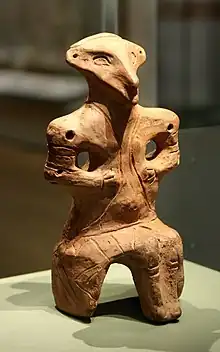
There were seventeen Roman emperors born in the territory of today's Serbia, more than in Gaul (France and Belgium), Iberia (Spain and Portugal) or indeed any other modern country's territory but Italy, and they all left monuments and built palaces in or close to their birthplaces. It may well be that the oldest ever found human settlements in Europe, if not in the world, can be found in country of Serbia. The longest stretch of the river Danube, longer than in any other European country is in Serbia. The giant hydroelectric dam of Đerdap has created a lake stretching for many miles out of the Đerdap Canyon with its famous Roman road to the East build by the Emperor Trajan.
The first Serbian state under that name was formed in the late 8th century, becoming a kingdom in the 12th century and expanding by the mid-14th century to an empire that comprised most of the Balkans. In 1389, however, the Serbs lost a decisive battle in the Kosovo field against the Ottoman Empire. Serbia managed to preserve its freedom for another seventy years, only to be finally overwhelmed by the Turks in 1459.
With several brief interludes of 2-5 years each and one longer one (1717-1739) when the territory of Serbia south of the rivers Danube and Sava was incorporated into the Austrian Empire, it remained under Ottoman rule until an uprising in the early 1800s grew into a full-scale war (Serbian Revolution aka First Serbian Uprising) led to the restoration of Serbian autonomy in 1815 and full independence in 1837. However, after 160 years under the Turks (the same as most of Croatia and Hungary), Northern Serbia (Vojvodina) was under the Austrian rule from the 1690s.
The 1914 Austro-Hungarian invasion of Serbia following the assassination of Archduke Ferdinand by an ethnic Serb high school student precipitated the first World War. In its aftermath in 1918, victorious Serbia gathered all south Slav lands (Croatia, Slovenia, Slavonia, Dalmatia, Bosnia and Hercegovina, and Montenegro) into the Kingdom of Serbs, Croats, and Slovenes; The country's name was changed to Yugoslavia in 1929. Invasion and occupation by Germany and Italy in 1941 during World War II was resisted by the communist-led guerrilla (Yugoslav Partisans), and at times by the Royal Yugoslav Army in fatherland (Chetniks), commanded by Lt.-Gen Dragoljub Mihajlović; Chetniks at times fought both invaders and Partisans, switching sides between resisting to openly collaborating with the invaders. The Partisans, commanded by Field-Marshal Josip Broz Tito, emerged victorious and formed a provisional government that abolished the monarchy and proclaimed a republic in 1946 after a dubious referendum. At the end of the war, nearly all ethnic Germans left the country. Although pro-Communist, J.B. Tito's new government was heavily anti-Stalinist and successfully steered its own delicate path between the Warsaw Pact nations and the West for the next four and a half decades.
In the early 1990s, post-Tito Yugoslavia began to unravel along ethnic lines: Slovenia, Croatia, and the Former Yugoslav Republic of Macedonia all split from the Yugoslav Union in 1991; and Bosnia and Herzegovina in 1992. All of efforts to preserve Yugoslavia were unsuccessful and bloody civil wars broke out in Croatia and in Bosnia. The remaining republics of Serbia and Montenegro declared a new "Federal Republic of Yugoslavia" (FRY) in 1992. Slobodan Milošević was elected the first president of Serbia.
In the late 1990s, the conflict with the Albanian separatist movement in Kosovo led to a NATO bombing campaign and direct intervention in support of the separatists, which ended with Kosovo placed under UN administration. Slobodan Milošević, by this time elected for the president of the federation, lost in the Federal elections in the fall of 2000 to Vojislav Koštunica. The country reestablished its membership in the UN and started preparations to join the EU. However, progress on EU accession talks has been slow, as the EU has demanded that Serbia recognise Kosovo's independence as a prerequisite for membership.
In 2002, the republics of Serbia and Montenegro began negotiations to forge a looser relationship, which led to the 2003 name change of the country to "Serbia and Montenegro". Serbia and Montenegro dissolved in June 2006 when the Montenegrin independence referendum was approved by a narrow margin. Kosovo unilaterally declared its independence from Serbia in 2008; however, this act remains unrecognised by Serbia and many other countries.
National holidays
January 1–2 (New Year's Day), January 7 (Eastern Orthodox Christmas), January 14 (working day) (Orthodox New Year), January 27 (working day) (Saint Sava's Feast Day), February 15–16 (Sretenje/Groundhog Day (Candlemas)/Serbian National Day), Good Friday and Easter Monday (according to Orthodox calendar), May 1–2 (Labour Day), May 9 (working day) (Victory Day), June 28 (working day) (Vidovdan/St Vitus Day) and November 11 (Armistice Day) are designated as state holidays. Major retail establishments such as supermarkets and shopping malls remain open on all of these days except January 1 and January 7. There are also several officially designated days on which only the members of certain religious minorities have the right for a day off. In practice this means that in the northernmost areas of the country, including Subotica, where there is a sizeable Catholic population, many shops close on December 25 - Christmas Day according to the Gregorian calendar.
Measures
Serbia, like most countries in the world, uses the Metric system.
Visitor information
Talk
- See also: Serbian phrasebook
The official language is Serbian, which is similar to Croatian and Bosnian, and mutually intelligible with them to a very high degree. Before the era of nationalist linguistic policies and the breakup of the former Yugoslavia, all of those dialects were all known as Serbo-Croatian. Today, people in the former Yugoslavia no longer use this general term for what remains essentially a common language.
Serbian is written using both the Cyrillic and Latin alphabets; the Cyrillic alphabet, which is considered more traditional, is the official script and used in most formal situations, but the Latin alphabet is used in most informal situations and is more common in daily life. The result of this is that most commercial signage is in the Latin alphabet, but government signs will be in Cyrillic as required by law. Similarly, broadsheet newspapers that focus on serious news are usually written in the Cyrillic alphabet, while tabloid newspapers are usually written in the Latin alphabet. Road directional signs are written in both alphabets.
English is widely spoken by younger adults who grew up after the fall of communism, and they are also quite willing to practise it with foreigners. On the other hand, older people who grew up under communist rule rarely speak English. You can also try German, French, and Russian, which are taught at school today or Spanish and Italian which some people learn on their own (there is also a number of Serbian guest workers in those, but not nearly as many as Romanian and Bulgarian ones, or as many as there are Serbian ones in Germany and Austria).
If you speak other South Slavic languages such as Bulgarian and Macedonian, this can occasionally prove to be helpful for you, as those languages have many similarities with Serbian. Older people may speak Russian, French or German as they were the main foreign languages taught in school during the Yugoslav era, though they have been largely supplanted by English among the younger generation.
In Vojvodina, most people speak Serbian, but other languages are also used. In some towns near the Hungarian border, you are more likely to hear Hungarian. There are many smaller minorities (Slovaks, Romanians, Roma people), who often speak their native languages.
In churches, the liturgical language is Church Slavonic, which differs significantly from any modern Slavic language.
Get in
Entry requirements
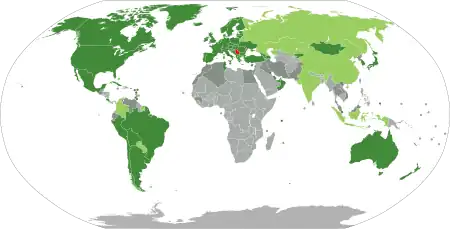
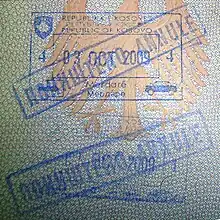
Foreign nationals of the following countries/territories can enter Serbia visa-free (Government website):
- For up to 90 days in 6 months: Albania, Andorra, Argentina, Armenia, Australia, Austria, Azerbaijan, Bahrain, Belgium, Bolivia, Bosnia and Herzegovina, Brazil, Bulgaria, Canada, Chile, Costa Rica, Croatia, Cuba, Cyprus, Czech Republic, Denmark, Estonia, Finland, France, Germany, Greece, Holy See, Hungary, Iceland, Ireland, Israel, Italy, Japan, Latvia, Liechtenstein, Lithuania, Luxembourg, Macau, Malta, Mexico, Moldova, Monaco, Mongolia, Montenegro, Netherlands, New Zealand, North Macedonia, Norway, Oman, Peru, Poland, Portugal, Qatar, Romania, San Marino, Seychelles, Singapore, Slovakia, Slovenia, South Korea, Spain, Sweden, Switzerland, Tunisia, Turkey, United Arab Emirates, United Kingdom, United States, Uruguay
- For up to 30 days, extendable up to 90 days within any 180 day period: Belarus, China, Kazakhstan, Russia
- For up to 30 days within any 60 day period: Ukraine
- For up to 30 days within one year: Bahamas, Barbados, Colombia, Georgia, Guinea-Bissau, India, Indonesia, Iran, Jamaica, Paraguay, Saint Vincent and the Grenadines, Suriname
- For up to 14 days: Hong Kong
Citizens of the following countries can enter and stay up to 90 days in 6 months with their National ID card: Austria, Belgium, Bosnia and Herzegovina, Bulgaria, Croatia, Cyprus, Czech Republic, Denmark, Estonia, Finland, France, Germany, Greece, Hungary, Iceland, Ireland, Italy, Latvia, Lithuania, Luxembourg, Malta, Montenegro, Netherlands, North Macedonia, Norway, Poland, Portugal, Romania, Slovakia, Slovenia, Spain, Sweden, Switzerland, United Kingdom.
Valid visa holders and residents of the European Union and Schengen Area member states and the United States can enter Serbia without a visa for a maximum stay of 90 days within 180 days, provided the visa remains valid for the entire length of stay.
Serbia has announced that visitors with Kosovar visas or passport stamps will not be allowed into the country. However, it seems that instead, the visas and stamps will be overstamped with a "cancelled" stamp. Entering Serbia through Kosovo without a Serbian entry stamp is considered as an illegal entry and can be met with stiff penalties; however, leaving Serbia via Kosovo is not a problem.
Customs controls are fairly straightforward, but a notable regulation is that you are allowed to move only 120,000 Serbian dinars (RSD) into and out of the country, and notes larger than RSD 1000 are not allowed to move across the border. You can take up to €10,000 through the border without declaration. Since bank transfers from Serbia are still difficult cash is still the easiest option for medium sums.
By plane
- Belgrade The main airport of Serbia is the Belgrade Nikola Tesla Airport (BEG), 15 km from downtown Belgrade. Major European airlines fly to Belgrade. Serbian national airline Air Serbia flies to all major cities in Europe, northern Africa and the Middle East. Another airline with many destinations from Belgrade is Wizz Air.
- Niš - Serbia's second international airport is in Niš: Niš Constantine the Great International Airport (INI). Air Serbia, Ryanair and Wizz Air operate here several routes. Airplane tickets to Niš tend to be very cheap, but planes fly there only from a few European destinations.
- Kraljevo (Morava Airport, also known as Lađevci) - small regional but international airport (KVO ), served by Air Serbia from Istanbul, Tivat, Vienna and Thessaloniki. There are no direct connections to town apart from taxi or rental cars. However, buses on the Belgrade-Kraljevo service pass along the highway 1km from the airport. To get there from Belgrade, buy ticket to Lađevci, ask the driver to be dropped off at the Tavnik gas station and walk 1 km to the terminal.
By train
Serbian railways are not in the best condition these days - as of summer 2022, most international train routes are closed, with direct trains from to Belgrade from Zagreb, Budapest, Skopje, Sofia, Athens, Vienna, Timisoara etc no longer operating. This might get better in the future, when the respective railways are upgraded/rebuilt. There might be some regional cross border services operating, but these are of a little interest to most visitors. The most useful one would probably be the Szeged-Subotica service, innaugurated in 2023.
The only international IC level train operating is one night express per day from Bar. The daytime express that offers scenic views on route operates only during the summer.
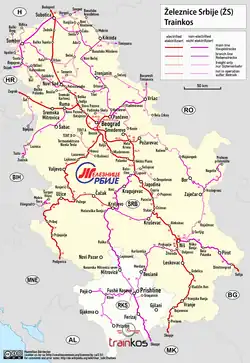
For timetables and all other infos check website of the Serbian passenger railway company.
A cheap way of travelling to or from Serbia might be the Balkan Flexipass.
By car
.JPG.webp)
If your vehicle is registered and insured in an EU country you do not need a green card. Otherwise, make sure that your Green Card has an uncancelled "SRB" box. Coming in from Hungary, the Szeged/Horgos border crossing is notorious for its congestion. If crossing the border from Hungary, try the Tompa/Kelebija crossing point, about 20 km west.
Police are generally stationed at major junctions or at underpasses to control traffic and speed. Drivers commonly warn others of a police presence by flicking the high-beams on two or three times. Police interceptors patrol all major highways. Drivers speeding and/or driving aggressively are stopped. Speeds of up to 140 km/h in 120 km/h zones are usually, but not always, tolerated.
The traffic law is strict. No person under age of 14 is permitted to ride in the front seat, seat belts are obligatory for all passengers, blood alcohol content is limited to 0.03% and fines start at €30 for smaller violations and go up to 60 days in prison and €5,000 for causing a larger traffic accident (both locals and foreigners). Keep in mind that if you kill someone in an accident, a prison sentence will be almost unavoidable. If you are driving on country and local roads, pay attention to the bicycle riders, tractors and other heavy agricultural machines, especially at night! They can be without proper light signalisation and hard to see, so slow down at night.
The highway is tolled, but the toll is no longer higher for foreigners than for locals. Highway tolls cost on average €0.03/km and can be paid in Serbian dinars or euros. They are charged by road section, so it's possible to pay more if only part of section is used. Main roads and populated areas are well covered with gas stations providing you wide range of common fuels (eurodiesel, unleaded petrol, etc.) LPG stations are not so numerous, but are in satisfying numbers on main roads and major cities.
Serbian Auto-Moto Association (AMSS) phone number is 1987 and they provide all kinds of services (information, tows, repairs). Private tow services can be expensive, some a blunt rip-off. Most of the major car companies have their appointed services in Serbia.
By bus
Vienna - Buses leave from Vienna International Busterminal (Erdberg) almost every day. For destinations south of Belgrade, Zoran Reisen coaches leave at 15:00 on Friday, and charge around €45 for a one-way trip.
For more information, see the timetable in English (arrivals/departures) of the Belgrade bus station, the Novi Sad public transport company page under "polasci sa autobuske stanice". Polazak.rs also has accurate timetables.
By boat
There are boat tours, which pass through Belgrade. These are Trafalgar Tours in English, which cruise along the Danube and have a two-day stopover in Belgrade.
By thumb
Hitchhiking across Serbia is still acceptable and most drivers will treat you like a friend. However, necessary precautions should still be taken. Generally, it is easy to hitchhike through Vojvodina and much more difficult to hitch a ride from Belgrade to the south, to Kosovo, or North Macedonia and Montenegro. The Hitchhiker's Guide to Serbia offers a collection of hitchhiking tips for a number of cities and towns in Serbia. It was made by the members of the Serbia Travel Club, an association of independent travellers from Serbia, and is available in English and Serbian.
By bike
The cycling route EuroVelo 6 which runs from the Atlantic Ocean to the Black Sea, crosses Serbia by following the Danube river. Most of the advised itinerary follows minor paved roads, and directions are clearly indicated by a specific EuroVelo 6 signage.
Although too few cities offer appropriate cyclist-friendly infrastructures, cycling is slowly gaining interest among the population as an economic and sustainable alternative way of touring and commuting.
Get around
Public transportation is generally not in very good shape outside of Belgrade. Trams and newer buses are exclusive to the capital, while intercity transport and transport within other smaller cities and towns uses older buses or more expensive minibuses. The coverage, however, is still pretty good in other towns as well. The quality of public transport within Belgrade itself is good and has vastly improved lately as most of the bus fleet was replaced by brand new gas powered buses.
The capital itself has around 120 public transport lines which can get you anywhere within the city you might want to go. A majority of these lines are bus lines, but some are trolleybus, tram and minibus lines.
Minibuses are way more expensive (~€2 per ride) than regular public transport as they are owned by private companies.
For more info check Belgrade#By_public_transport.
By bus
The most common and convenient way of getting around Serbia is by bus. See Bus travel in the former Yugoslavia for more information. For timetables (though not the prices) you can check polazak.rs
By train
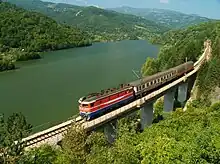
Trains in Serbia are considerably slower than most of Western/Central Europe, but they can be a quite scenic way of seeing the country. On most of the routes trains are also slower than buses, exceptions being the lines running from Belgrade to Novi Sad, and to the Croatian border (Šid). They can be a lot cheaper (up to 40%), however. Trains are considerably more often on time, but the intensity of rail services has been decreased on most lines (with some international lines being suspended).
Most railways journeys are operated by new trains (Stadler Flirt for electrified lines and Metrovagonmash RA-2 for non-electrified ones, but you can still find some of the older trains in use on peripheral lines (JŽ class 412/416 made in the Soviet Union), and even some of the old East German diesel rail-buses (Šinobus), latter, mostly in regional use in Banat) and more regular locomotive-hauled trains serving international lines.
All trains are operated by Serbian Railways' passenger branch SrbijaVoz . (timetables available, though, for some reason, prices are available just for certain routes. For train prices for all routes you can check polazak.rs . You would need to choose a railway station in the places you are travelling to (marked with a train symbol, and followed by ŽS.
In 2022 a train line from Novi Sad to Belgrade was opened. This is a semi-high speed rail, reaching Novi Sad in around 30 minutes. The ticket costs RSD400.
Train types
There are several train types in regular passenger service, but the type of the train rarely influences the actual journey time, or train speed. They also differ slightly in prices.
Brzi (Fast) trains (marked with a B on timetables), which theoretically stop on fewer stops (though this mostly means, the most peripheral ones).
RegioEkspres trains (marked with a Re on timetables), which stop on most stations (this usually means all).
These two types of trains have a supplement that is added to the ticket (50 RSD for journeys up to 50 km, and 100 RSD for journeys over 50 km, for Re trains, and 100 RSD for B trains)
Putnički (Passenger) (marked with a PT on timetables) trains, which stop at all stations and don't have a supplement. This type is becoming increasingly uncommon as ŽS is phasing it out in favour of Re trains.
Train travel times and prices
Train travel in most of Serbia is in no way time-saving, though it can be a very good option for budget travelers. There are (in theory) two classes in B and Re trains (1st and 2nd, 1st being 20% more expensive)), though this is increasingly meaningless as new Stadler and Metrovagonmash trains have very few 1st class seats (4 in every train), and they are almost always taken by the conductors, and getting them to move can be challenging. There is almost never a 1st class carriage on most international trains either.
Travel times on most lines are much longer than travelling by bus, and many cities in Central Serbia aren't connected to Belgrade directly (and timetable planners don't make it a priority to allow for fast and easy changes). This situation leaves a prospective train traveler with few possibilities of enjoying rail travel to smaller cities.
Generally, it is easier, cheaper and more comfortable (and sometimes faster) to take a train from Belgrade to Novi Sad (40 mins, ~400 RSD one way). Traveling from Belgrade to Niš is another option, though this journey is much longer than by bus (~5½ hr opposed to ~3 hr), and can get very uncomfortable if you're traveling in newer Stadler trains, as their seats were built for shorter travel times (it can also be very frustrating to sit in a completely modern train with an LCD screen constantly showing you travel speeds of 45 km/hr). This journey can, on the other hand, be a very nice, and scenic experience, if you, for example, take a PT train from Zemun (departing Belgrade Centre station at 15:22 and arriving at 20:52, costing 784 RSD) which is still operated by old compartment carriages and locomotive hauled (and almost always completely empty (June 2022).
The long-lasting change (starting in the 1980s) of Railway Terminals from Glavna Železnička Stanica Beograd (Belgrade Main Railway Station) to Beograd Centar/Prokop (Belgrade Centre/Prokop) has been (as of the 2017/18 timetable) completed. All trains go to Beograd Centar, the old station has been closed permanently. The problem with this is that Beograd Centar is mostly unbuilt, having only the platforms and no station building, and being infamously hard to reach (as Belgrade locals like to say, it has only 1½ bus lines going to it (one going from nowhere to nowhere and another (very irregularly) going from nowhere to Slavija square). If you are going from Novi Sad, Subotica or Šid, you should consider exiting the train at Novi Beograd and taking a bus or a tram to the city centre. Or you could take the city railway (BG:Voz from Beograd Centar either to Novi Beograd or Karađorđev Park/Vukov spomenik, which are more centrally located. Avoid trains arriving late at night because neither Novi Beograd Station nor Belgrade Centre are a good place to be at night, and there is virtually no public transport there after 23:00. Beograd Centar was built as a railway hub for the Yugoslav Railways, and was planned for many more and much bigger trains that it sees now, so be sure you're waiting at the right platform and stay close to the middle, because otherwise you might miss your train.
You must buy tickets at the train station before boarding the train (unless the ticket window is closed (usually only very late at night, and never in main cities). A ticket is valid for a specific train, not (as is common in Western Europe, a line), so you can't hop-on hop-off. Tickets are not sold online.
The cashiers usually speak little English, so you should have a piece of paper with your destination written on it, and if you don't want to the next train, the number of that train. The cashier will sometimes ask you if you want a reservation, and if you speak no Serbo-Croatian, they will usually put it without asking. This reservation costs RSD110, and has no real purpose, as it only guarantees you a seat, and trains are almost never full (except the Belgrade-Novi Sad line). Also, even if you have it, conductors can be unwilling to fight other passengers to give you the seat, and you can bet that no one on the train will have a reservation for a particular seat you take. If you don't wish to take the reservation you should just say bez rezervacije (bez rezervatsiye) when buying a ticket.
By car
Roads are in a good shape. The main motorways are completed, going in East/West and North/South direction, with toll gates at every exit and before major cities. When going outside the motorways, the roads are well maintained, but full of pedestrians, and somewhat erratic drivers. Aside from the motorways, the roads usually go through the centers of towns and villages, which slows down most journeys. As the public transportation is often lacking, cars tends to be the only viable way of getting to more remote parts of the country. Police checks are common like in other European countries (not very common). Google Maps and other major navigation providers work well in Serbia, just prepare yourself with offline maps if you don't want to spend a fortune on data roaming.
Gas is usually slightly cheaper than in nearby EU countries, but still expensive by non-european standards.Shopping around for cheaper gas is not necessary.
In Serbia, there have been attempts to scam motorists by stopping a car and telling them it is faulty. Tourists are advised to go to a local garage to have their car repaired, where exorbitant repair prices are charged. Scam attempts have been made on the Belgrade-Nis motorway, among others. It is advisable to use only authorised repairers.
See
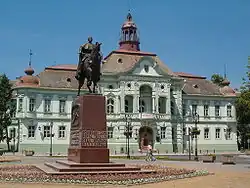
Serbia's many sights include stunning castles, Medieval monasteries, lovely traditional villages and bustling cities with baroque parks and art-deco architecture.
Cities and villages
Its capital, Belgrade, is a lively and upcoming European city with the Sava and Danube rivers running right through it. Certainly not a boring city, it has a plethora of interesting destinations, old and new.. Stroll through Prince Michael Street, the cities main pedestrian street, or stop by for a drink in one of Skadarlija 's many restaurants. There are a lot of old buildings on all four banks, including the huge Kalemegdan Fortress, that has been built, modeled and remodeled by the Celts, Romans, Byzantines, Serbs, Austrians and Turks in a time span of over 2000 years. Once an important military fortification, it now serves as a central park of Belgrade with beautiful views facing the north-west. Within the fort is a zoo, a military museum, a couple churches rich in history, galleries, parks, sports fields, etc. It has a multitude of various towers and ports, and two long walking/biking paths along both rivers. Other Belgrade sights include the modern Temple of Saint Sava, the National Museum and the Old Court Palace. The river island Ada Ciganlija has an artificial lake and an 8 km long gravel beach, and is a close option if one doesn't want to bathe in pools. Should one want the contrary, Tasmajdan park is, along with the famous church of St. Mark, filled with pools and even houses a water polo team. It's a lively place with lots of sports and entertainment, cafes and restaurants, some of which are opened the whole year round. Zemun, now part of the Belgrade urban area, developed under Hungarian and later Habsburg influence for most of its history and is a pleasant area with a distinct feeling dissimilar to Belgrade. It offers plenty of entertainment and restaurants on its Zemun quay, on the bank of the Danube.
Novi Sad is another delightful city, with the Petrovaradin Fortress (one of the greatest and best preserved 18th-century fortresses in Europe) as its main sight. The city also has a number of lovely parks that just ask for a long afternoon stroll or picnic. Sremski Karlovci near Novi Sad has a rich history, numerous monuments, museums, churches, galleries and famous wine cellars. Town of Novi Pazar, your last stop before Kosovo, has a distinct Turkish heritage and a bunch of great monasteries in the surrounding area.
Mokra Gora is a village reconstructed in a traditional style in the popular mountain region of Zlatibor. The village of Sirogojno is in the same region, with a nice open air museum and lots of traditional crafts on display. Very nearby is the traditional village of Drvengrad, also known as Mećavnik, which the Serbian film director Emir Kusturica built for his film Life is a Miracle. After you see the villages, Zlatibor offers some great ski-resorts, hiking trails and landscapes. Or hop on the Šargan Eight, a narrow-gauge heritage railway running from Mokra Gora to Šargan Vitasi station (Zlatibor and Tara mountains). When it comes to the number of bridges and tunnels, and the rise of 18 per thousand, Sargan Eight is unique in Europe and a ride on the 8-shaped track is a popular pass time for tourists.
Monasteries
Serbia is home to a great number of Medieval orthodox monasteries, many with excellent fresco masterpieces inside. The 12th-century monastery of Studenica (near Kraljevo) is one of the finest examples and recognised by UNESCO as a World Heritage Site. Its two churches are built in white marble and boast some stunning 13th and 14th century Byzantine paintings. Žiča, also near Kraljevo, was founded around 1207 and painted red as a symbol of the blood of the martyrs of the early Christian church. The frescos at Sopoćani (near Novi Pazar) are considered some of the finest examples of their time, and the monastery is on the World Heritage list together with ruins of ancient Stari Ras, once the capital of the Serbian state of Raška but deserted in the 13th century. The fortified Manasija monastery near Despotovac is protected by massive walls and towers, and although much of its original frescos were damaged beyond repair during the Ottoman rule, it's still well worth a visit. In the beautiful Kučaj mountains, Ravanica near Ćuprija was assaulted, damaged and rebuilt time and again during history. It is the burial place of Lazar of Serbia, who is a saint of the orthodox Serbian church and a hero in Serbian epic poetry. Other fine monasteries include the Mileševa monastery near Prijepolje, with its world famous "White Angel" fresco, and Krušedol near Syrmia. The famous medieval monasteries were protected by UNESCO are: The Pec Patriarchate (monastery), Gracanica monastery, and the monastery of Visoki Decani.
If you stay only in Belgrade, be sure to visit Frescoes museum in the centre which will provide you with a glimpse of a Serbian fresco paintings as it holds copies of the most famous and beautiful frescoes from various monasteries.
National parks

Of the several national parks and natural areas in the country, Fruška Gora is undoubtedly one of the best. Dotted with ancient monasteries and wineries, it combines orchards and vineyards on its vast plains with tight forests on its plains. The Tara National Park covers some 20,000 hectares in the west of the country. There, the steep gorges of the Drina river and the high mountain peaks provide some stunning views that make a long hike well worth your effort. The mountainous landscape of Kopaonik, in the south, offers some great ski and snowboard opportunities, great views and a rich flora.
Largest national park in the country is Đerdap in the eastern part of the country, on the border with Romania. It consists of the Djerdap (Iron Gate) gorge through which the river Danube runs and its beautiful surroundings of almost untouched nature. It is simply breathtaking and best experienced from a boat cruise. It can be also toured by bus or a car with many belvederes to stop and enjoy its views. EuroVelo 6 cycling route also runs through it.
Spas and resorts
Serbia is the land of spas. There are many thermal and mineral water springs and most of them are turned into healing and resting resorts. Vrnjačka Banja is the largest and most popular of them and is traditionally very attractive tourist resort for rest and recreation. It's the only mineral spa with a water temperature to match that of the human body, 36.5 °C. Sokobanja is another famous spa and tourist place in Serbia known for its moderate continental climate and untouched nature - immense surfaces of woods, fresh air and a lot of thermo-mineral sources. Palić is a lovely city in the north. Its baroque parks, monuments of art nouveau architecture and a long tradition in catering made it a fashionable summer resort and spa for the 19th and 20th century elite.
Archeological sites
.JPG.webp)
Viminacium near the village of Stari Kostolac is an important archaeological site and was Serbia's first excavation project in the 1880s. It was once the provincial capital of the Roman province of Moesia (today's Serbia) and dates back to the 1st century. At the site you'll find archaeological remains of temples, streets, squares, a large amphitheatre, palaces, hippodromes and Roman baths. Another major archaeological site (and doubling as a spa) is that of Gamzigrad. It hosts the remnants of an ancient Roman complex of palaces and temples called Felix Romuliana, and is considered one of the most prominent and best preserved late-Roman sites.
Lepenski Vir, situated in national park Đerdap, 160 km east of Belgrade, between towns of Golubac and Donji Milanovac, is the site of oldest neolithic settlement in Europe and is part of UNESCO world heritage. It is very well preserved and famous for its fish-like sculptures. From neolithic period there is also an archaeological site Vinča, less spectacular though, but a must - see. It is in Belgrade suburb of Vinča, 20 km from city centre.
Sremska Mitrovica is a town over the remainings of Sirmium, a provincial capital of the Roman Empire, destroyed in attacks by Avars in 505 AD. The remainings are under the whole town, but there are exposed excavations on several places. Ten Roman emperors were born in or around Sirmium. It was the capital of the Panonnia province and the Praetorian prefecture of Illyricum.
Do
Ada Ciganlija is also an excellent place to kick back and relax during summer. It is as locals call it the sea of Belgrade. A lot of sport fields and courts (soccer, basketball, golf, volleyball, etc.) Cafés serving ice cream and beer abound on the banks of this lake-beach park.
A favourite leisure activity in Belgrade is drinking coffee in numerous bars, bistros and cafés (especially in Strahinjića Bana street, which is known locally as Silicon Valley). It is very strange, but most of places are occupied all day long - i.e., within working hours. You should check: Downtown café, Buka bar, Movie bar, Iron café, Biblioteka café, Monza café-boat, Bibis café-boat, and many more; People who are not in the folk and MTV music, and don't like to drink overpriced coffee, should avoid this street. There are coffee bars on almost every corner in Belgrade, which offer more relaxed atmosphere and are designed with more taste that those in Strahinjića Bana street.
Smederevo is a town about 50 km from Belgrade. There are direct bus lines almost every half an hour and it takes about one hour to get there from Belgrade. It is considered as the unofficial rock 'n' roll capitol of Serbia because of its many rock musicians and bands who live there or were born there. See the largest lowland medieval fortress in Europe (especially at night when its lights give a special romantic and mystical atmosphere) or go to a rock concert at "Moto Club Street Fighter" which is on the bank of the Danube. At the end of September, the town hosts a traditional festival called "Smederevska Jesen" (Smederevo Autumn) which is a festival of vine and Serbian culture with many concerts and other happenings. During the festival, there is a carnival at the end of the town, but avoid it because it's loud and crowded and basically, there's nothing to see or do. Just stay in the town centre. The Museum of Smederevo holds a lot of Roman and medieval items and collections, so for history lovers, it's a must-see.
Football: some 16 clubs play soccer in Superliga (Суперлига Србије), the country's top tier, with four of them based in Belgrade. The national team usually play at Red Star Stadium in Belgrade.
Festivals and nightlife
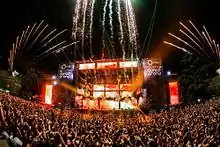
Foam Fest - Belgrade Foam Fest is a spectacular electronic music stage event. It began in 2009 and more than 60,000 people have visited it since then. LED screens arranged all over the Arena, with hundreds of light guns, lasers, robo heads and other light and sound equipment, numerous foamfalls and foam guns will classify this event again as a manifestation that sets new production standards in Serbia and the region Belgrade Foam Fest.
Exit festival – Biggest music festival in SE Europe, that is happening in the beginning of July, in Novi Sad, on Petrovaradin fortress .
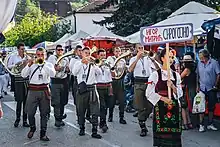
Festival of traditional brass bands, "Trumpet Festival" in Guca village is held every year at the beginning of August.Festival of traditional brass bands, "Trumpet Festival" in Guca village 20 km from the town of Cacak. During the festival in this small town a few days to go over half a million visitors.The festival in Guca is perhaps the biggest festival of this type, including a lot of visitors from abroad.
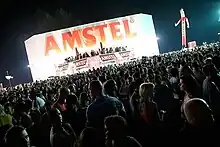
Belgrade Beer Fest, which takes place at Ušće every August offers a taste of domestic and foreign beers and some good rock music .
Belgrade is very famous for its all-night-party clubs. If you are looking for a place to feel the local atmosphere and good vibes, visit bohemian street “Skadarlija”. Please have a look at the Belgrade article for further options.
New Year's Eve
Restaurants, clubs, cafés and hotels are usually full-booked and organise New Years celebrations with food and live music.
However, Serbian New Year's celebrations are most known for the outdoors festivities in Belgrade, and several other major cities such as Novi Sad, Niš and Jagodina. As of mid-December, cities are extensively decorated and lit. The decorations remain until way into January due to the persistent influence of the old Julian calendar. Throughout the region, especially amongst former Yugoslav republics, Belgrade is known as the place to be for major parties, concerts and happenings. It has become common for large groups of Slovenes to visit their former capital and celebrate the beginning of a new year. Especially since the mid-1990s, street celebrations grew into mass gatherings with hundreds of thousands of people, celebrating New Year on one of several locations throughout Belgrade.
Also, on January 14, Serbians celebrate the so-called Serbian New Year, which is New Year's Eve by the Eastern Church calendar. In the night between January 13 and 14, you can re-live New Year's Eve.
Buy
Money
|
Exchange rates for Serbian dinari
As of January 2024:
Exchange rates fluctuate. Current rates for these and other currencies are available from XE.com |
The currency in Serbia is the dinar (denoted by РСД or динар, pl. dinari/динари). The ISO currency code is RSD.
Coins of Serbia are minted in denominations of 1, 2, 5, 10, and 20 dinars, and banknotes are printed in denominations of 10, 20, 50, 100, 200, 500, 1,000, 2,000, and 5,000 dinars. The banknotes tend to be more common than the coins, so be prepared to carry around a large number of banknotes in varying conditions.
Serbian taxis, street vendors, and small restaurants will rarely have change for larger denominations (especially 5000 dinara notes). Travelers would be wise to spend these at department stores or large grocery stores to keep an adequate supply of small notes on hand.
Money can be exchanged at official exchange offices, locally called menjačnica, often carrying the emblem of the National Bank of Serbia outside the building. The rates here are usually better than those of the banks. It is much easier to convert euros or other major currencies. There are many ATMs, which accept foreign bank and credit cards without a glitch. Visa, Visa Electron, Mastercard and Maestro are widely accepted. However, American Express and Diners Club cards are rarely accepted. Likewise, traveller's cheques are not a well known form of payment in Serbia and cashing them in could present a challenge.
The dinar is not widely convertible outside of Serbia; re-convert your remaining dinars to euros or other major currencies before leaving the country.
Old Yugoslavian currency can be purchased from street sellers. A RSD 500,000,000,000 note makes an interesting souvenir. At Kalemegdan, near the fortress in Belgrade, you can pick up a set of 10 banknotes from the hyperinflation era for RSD 600.
The euro is occasionally accepted, but prices are often higher when directly compared to the dinar. Prices of expensive items such as housing or cars are listed in euros only. Belgrade is typically on par with prices in many European cities; however, outside the capital, prices of almost any item are a lot lower than in the capital.
Money changers may refuse worn-out or damaged foreign banknotes, especially US dollars, therefore it is recommended to bring notes only in good condition. Banks usually accept slightly damaged notes, sometimes with a commission.
Gas stations close to borders sometimes accept foreign currencies.
As of July 2024, Halkbank seems to be the only bank that doesn't charge any ATM withdrawal fees.
Tipping
Tips are never considered a strict obligation since service charges are always included in the bill, however rounding up or leaving a tip (10-15%) is common in restaurants (not in fast-food restaurants) if the customer is satisfied with the service. Tips are also accepted in bars and taxicabs (usually by rounding up the amount paid - e.g. if the taximeter displays RSD 592, give 600).
Shopping
Imported western food is available in many supermarkets, especially in the "Idea" chain.
In nearly all Serbian pharmacies (apoteka), you can buy prescription drugs without prescription.
Prices tend to be on par with the rest of the Balkans. However, import taxes make clothes and shoes in Serbia very expensive.
Eat
- See also: Balkan cuisine
Serbian food is a typical Balkan mix of Central European, Mediterranean, and Middle Eastern dishes. Serbs are very proud of their food, which is heavy on grilled meats and sausages, local cheeses and bread. Serbia is predominantly a meat-loving nation. In all major cities, there are many international restaurants, such as Italian, Chinese, Mexican, Thai, Lebanese. In Belgrade you can even find sushi or kosher food.
There are international fast-food franchises such as McDonald's, KFC, and Pizza Hut. On the whole, prices are cheap compared to Western Europe with main dishes ranging from RSD 600 to 2400 per person.
Typical Serbian foods
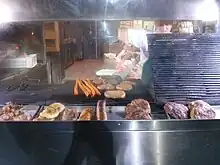
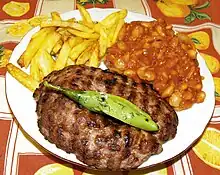
Most Serbian restaurants offer roštilj, a large plate of various grilled meats, or any possible variety of grilled chicken wrapped in bacon and stuffed with cheese. It is possible to order fresh salads, plates of grilled vegetables, crepes, or omelettes if you are not carnivorous. Serbian cuisine is famous for its heavy use of varied vegetables, fresh or cooked.
Bakeries – called pekara – are ubiquitous in the city centre, and you will find a wide assortment of breads, sweet and savoury pastries, sandwiches, and pizza. Some are open 24 hours per day. A snack or light meal of pastry and drinkable yoghurt (similar to kefir but milder) will give you an added healthy boost when walking about the city centre.
Turkish delicacies such as baklava, tulumba, and other sweet treats are also commonly found.
Foods that vegetarians and meat eaters alike should try include kajmak (something between cream cheese and butter) and ajvar, a savoury spread made out of roasted red peppers. It is also worth visiting a pijaca (green market) to buy some fresh fruit, vegetables and other grocery items.
Pljeskavica (pronounced approximately: PLYES-ka-vitsa) is the Serbian version of a hamburger which can be purchased from fast food restaurants.
The most famous dish in Serbia is ćevapčići (pronounced: chay-VAH-pee, chay-VAP-chitchee). Also called Ćevapi, they are a traditional food eaten throughout the Balkans. It consists of different types of minced meat (pork and beef) mixed together, shaped like small sausages, and then put on the grill. It is usually eaten with diced onion, and is very tasty. Depending on size, a portion of ćevapčići in a somun (pita bread), possibly with onion, ajvar or kajmak, is between RSD 180 and RSD 480.
Do not forget to taste the Karađorđeva Šnicla. It is meat that is filled with kajmak and bacon, and then pan-fried. It is another traditional Serbian dish that honors the leader of the first Serbian uprising against the Ottomans.
Try other traditional Serbian dishes, such as pečenje (roast pork or lamb), veal soup, and fish soup.
Burek (pronounced BOO-rek) is considered a national dish. It is made with a range of fillings including meat, cheese, spinach, apple or cherry. Due to the high fat content it is not for dieters. it is often eaten in the morning and can be sold out by the evening.
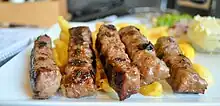

.jpg.webp)
- Ćevapi (Ћевапи) -something like a Mixed grilled meat (one serving contains 5 or 10 pieces)
- Pečenje (печење) -roast pork or lamb-roast
- Kiflice (кифлице) (KEE-flitsay) small crescent-shaped bread rolls.
- Paprikaš (Паприкаш) (PAP-rik-ahsh) - stew with paprika often with chicken
- Gulaš (Гулаш) (GOO-lash)) - stew with paprika with beef
- Sarma (сарма) (SAR-ma) cabbage rolls, similar to dolmades, but made with sauerkraut instead of vine leaves
- Gibanica (Гибаница) (GHEE-ban-itsa) - phillo pastry made into a pie with spinach and cheese or just cheese (like spanakopita or tiropita in Greece)
- Lepinja (комплет лепиња или лепиња са све) - baked egg and cream inside of bread loaf.
- Punjene Paprike] (Пуњене паприке) - stuffed peppers (POON-yennay PAP-rik-ay)
- Pohovane Paprike (Поховане паприке (PO-ho-vah-nay PAP-rik-ay) - paprika rolled in soya oil and wheat flower and fried in sunflower oil, for vegetarians
- Pasulj (Пасуљ)(PAS-ooy) - beans. A national specialty. Often cooked for a long time with onion and paprika.
- Riblja čorba (рибља чорба) (RIB-yah CHOR-ba) Fish soup using freshwater fish.
- Roštilj (Роштиљ) (ROSH-teel) - barbecued meats.
- Prebranac (пребранац) (pre-BRAH-nats) - is for vegetarians. It's cooked and roasted beans with various spices and vegetables. Usually completely meat free.
- Teleća čorba (Телећа чорба) -veal soup
- Proja (Проја) (PRO-ya) - a type of corn bread with white cheese. A national specialty.
- Ajvar (Ајвар) - ordinary red pepper, freshly ground and roasted and then made into a chutney.
- Kajmak (Кајмак) -something between cream cheese and butter.
Vegetarian foods
Pure vegetarian restaurants are rare, but many places will provide you with non-meat food (just ask for 'posno'-general term for non - meat foods). Numerous fast-food stands (burgers, barbecue, pizza, hot dog, pancakes...) and bakeries (Asian and European pastry, pitas...) are usually very good and will satisfy your needs at a reasonable price. Pizza, sandwiches, and pancakes (crepes) are also commonly found. Salads are primarily tomato, cucumber, and onion, or cabbage. Local produce is fresh and organic.
Serbian-style coffee
Coffee culture in Belgrade is particularly developed; walking about the central areas of the city you will find sprawling terraces and cafés, serving all types of coffee and sweets, particularly Viennese type cakes and local specialties. Be sure to try Serbian Turkish-style coffee, and chestnut purée with whipped cream, a local specialty especially at Republic Square (available mostly during winter).
Drink
.jpg.webp)
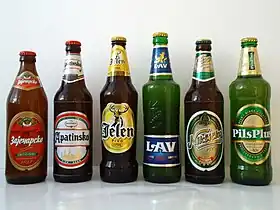
- Rakija (Ракија) – excellent brandy that has many flavours, like plum Slivovitza (Шљивовица - pronounced like SHLYEE-va), quince (Дуњевча - DOO-nyah), apricot (Кајсијевача - KAI-see-yah), Pear (Крушковача), plum-juniper (Клековача - mix between rakija and Gin)... You should know that some prestigious brands of rakija can be extremely expensive like Žuta Osa (ZHOO-tah O-sah), which means Yellow Wasp, or Viljamovka (VEE-lyam-ovka), a kind of poire william which in its most refined and expensive varieties has pear fruit in the bottle.
- Loza – grape brandy, grappa, a type of rakija
- Voda = Water
- Slivovitza (Шљивовица) – plum brandy - the national brandy of Serbia, and the most common type of Rakija, very popular, variably strong alcoholic beverage
- Serbian wine is delicious and comes from many wine regions, including Syrmia (especially town of Sremski Karlovci, also Irig), Oplenac, Župa, Smederevo, Negotin and Metohija.
- Beer (Пиво) – Jelen (Deer) and Lav (Lion) are the two most popular varieties of Serb beer, although Nikšićko from neighbouring Montenegro also seems very popular.
- Spring mineral water (Вода) – there are plenty of excellent bottled spring mineral water, from natural resources and protected areas.
- Mineral water (Минерална Вода) – in Serbia there are plenty of well-known springs (spa) mineral water (slightly sour, with a natural carbon)
Sleep
Stay safe
.jpg.webp)
Serbia is generally a safe place to visit. The locals are incredibly polite and helpful in case you require any assistance. (If you need any help finding/reaching a place, it's best to ask a younger person for help, as they are more likely to speak English.) However, you should always be aware of pickpockets, mainly in crowded tourist places and on public transportation. Street robberies, assaults or murders are highly unusual, even in dark or remote parts of a city/town. One should always watch out for drivers, who can be very rude to pedestrians or cyclists. There is also widespread intolerance against LGBT people.
Emergency phone numbers are: 192 - police; 193 - fire dept. and 194 - ambulance.
Following the Yugoslav wars of the 1990s, reports of UXOs (unexploded ordnance) have occurred outside the major cities. Keep an eye out for markings which may signify a potential UXO zone when outside the cities and always stick to well-trod paths. If you find a suspicious object resembling a bomb/mortar/landmine, don't touch it. Report it to the nearest police station immediately. Most UXOs have been cleared, though, so it is very unlikely that you will find any.
Floods are common in spring and autumn in river basins - the Danube, Sava, Tisza and Drina.
Serbia is located in a seismically active area, so earthquakes are possible. However, earthquakes causing major damage are rare. The last recorded earthquake was in Kraljevo in November 2010.
Stay healthy
Tap water is perfectly safe to drink, and mainly of a good quality, too. There are also many springs and fountains with excellent-quality drinking water - the most popular ones being the fountain on Knez Mihailova in Belgrade, and the many fountains in the city of Nis. One must pay attention when it comes to water in Vojvodina. Some regions (like Kikinda and Zrenjanin) have heavily polluted water that is not even used for cooking, only as industrial water.
Respect
Serbs are a very friendly, polite and hospitable people, especially in the southern parts of the country.
When you are invited into a Serbian home, make sure to bring them a gift if you are coming for the first time. Anything is fine from flowers to chocolate or something representative from your country. When you arrive at a rural house, take off your shoes unless the owner explicitly tells you to keep them on. When inside the house, don't ask for anything, for they will surely offer it. If you are thirsty it is polite to ask for a glass of water. The host probably forgot to offer you a drink and will do so.
In a bus or a tram it is considered polite to offer an elderly person or a pregnant woman a place to sit.
Because many Serbs feel frustrated by the 1990s Yugoslavian Wars or the NATO bombing of Yugoslavia, it is best to avoid discussion of them. If someone brings the topic up, try to avoid giving any strong opinions until you can assess your acquaintance's views. Do not voice support for Kosovo's independence. The U.S.'s vocal support of Kosovar independence and the 1999 air strikes caused some ill will directed towards the West, particularly towards the U.S. (though this is rarely extrapolated to individual American tourists). However, if you share the views of most Serbs, some may be willing to discuss the subject and many will be happy speaking to a Westerner who shares their views.
On the other hand, talking about Socialist Yugoslavia and Tito will not raise as many eyebrows, as most will not hesitate to talk about it and some may even approach it with a strong degree of affection towards that more stable and more peaceful era. Serbia does not recognise the independence of Kosovo but maintains diplomatic relations with Slovenia, Croatia, Bosnia-Herzegovina, Montenegro, and North Macedonia.
Like the citizens of other ex-Yugoslavia countries, Serbs do not like their country to be described as part of "Eastern Europe". A common misconception is that Serbia was part of the Soviet Bloc (in fact, it was part of Yugoslavia, which split with the Eastern bloc in 1948).
Unlike in most other European nations east of the Iron Curtain where anti-Russian sentiment is high due to Soviet dominance over those nations during the Cold War, in Serbia, Russians are generally seen as friendly brotherly people. People have no problems talking about the communist period or Tito and often express nostalgia for it. Serbian views of the Russian invasion of Ukraine are also pretty mixed and there are quite a few (very vocal) people who support the invasion. This however does not necessarily apply to the entire nation and many people who have experienced the Yugoslav wars will be against the war despite disliking Western countries (especially the U.S.).
When toasting in Serbia, as in most European countries, make sure you make eye contact. You may be invited to drink gallons but are expected to be able to hold your drink. Being obviously drunk is a sign of bad taste, lack of character, and worse. Be careful: "rakija", a plum spirit (usually about 53% alcohol content), is stronger than you might expect, and will make you drunk fast! It is always nice to toast in your companion's native tongue. Cheers is živeli in Serbian.
Don't point with your finger at someone. This is considered rude.
Socially, displays of affection among the younger generation are as in Western Europe, but the older generation (over 65) is quite conservative.
The word molim (please) is key to polite conversation in Serbian. It basically means please, but also you're welcome, an appropriate response when somebody thanks you (and says hvala). It also means I beg your pardon?. Just saying Šta? (What?) can sound rude. It may be said that the usage of the word molim is similar to the usage of bitte in German.
Like most European languages, Serbian has formal and informal ways of saying you (Vi and ti). Use the formal Vi version when addressing older people. People are normally not addressed or referred to by their first names, except among friends or relatives.
Although Serbia is constitutionally a secular state, the vast majority of Serbs follow the Serbian Orthodox Church, part of the Eastern Orthodox communion, and the church continues to play an influential role in Serbian society. Nevertheless, so long as you are respectful, you should not have any major problems regardless of what religion you practise, or even if you are an atheist.
Connect
There are three GSM/UMTS mobile phone networks in Serbia: MTS, Telenor and Vip. Prepaid SIM cards usually cost RSD 200-300 and there is no need for identification when buying them at a store in person. Most small stores and kiosks that sell newspapers and cigarettes in Belgrade offer the SIM cards. A good option (as of April 2018) is the VIP 7-day card for 300RSD including 8GB of LTE Internet (but no call or SMS credit).
But you need to have a valid Serbian ID for online order of prepaid SIM card from Telenor (the only operator known which takes online orders).
In some stores you can buy a simple mobile phone packaged with prepaid SIM card for RSD 2000–3000.
Don't forget that Serbia is not in the EU, so using a SIM card issued in an EU country will cost you a fortune.
Most hotels have internet connections, and plenty of restaurants have Wi-Fi hotspots.
Go next
The land border can be crossed to Croatia, Hungary, Romania, Bulgaria, North Macedonia, Kosovo, Montenegro and Bosnia and Herzegovina.
Serbia has ultra-low-cost flights to several European countries and from Belgrade to Abu Dhabi in the United Arab Emirates. (updated May 2022)
